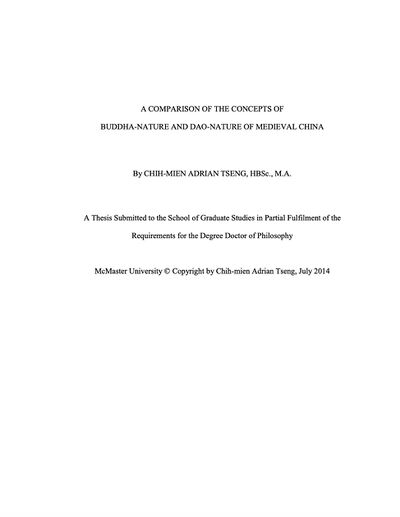A Comparison of the Concepts of Buddha-Nature and Dao-Nature of Medieval China
< Books
| Line 2: | Line 2: | ||
|BookParentPage=Secondary Sources | |BookParentPage=Secondary Sources | ||
|FullTextRead=No | |FullTextRead=No | ||
| − | |BookToc={{i|'''Introduction'''|1}} | + | |BookToc=* {{i|'''Introduction'''|1}} |
* {{i|1. Discussion of previous scholarship|2}} | * {{i|1. Discussion of previous scholarship|2}} | ||
* {{i|2. Methods and questions addressed in this project|8}} | * {{i|2. Methods and questions addressed in this project|8}} | ||
| Line 10: | Line 10: | ||
* {{i|6. Chapter summaries|32}} | * {{i|6. Chapter summaries|32}} | ||
| − | {{i|'''Chapter 1: An Examination of the Relationship between Human Nature and the Nature of Inanimate Things in Chinese Thought'''|36}} | + | * {{i|'''Chapter 1: An Examination of the Relationship between Human Nature and the Nature of Inanimate Things in Chinese Thought'''|36}} |
* {{i|1. The discussion of xing 性 in terms of the nature of mind before Xuanxue 玄學 (Arcane Study)|38}} | * {{i|1. The discussion of xing 性 in terms of the nature of mind before Xuanxue 玄學 (Arcane Study)|38}} | ||
* {{i|2. The discussion of xing in terms of ontology|49}} | * {{i|2. The discussion of xing in terms of ontology|49}} | ||
| Line 18: | Line 18: | ||
* {{i|4. Conclusion|84}} | * {{i|4. Conclusion|84}} | ||
| − | {{i|'''Chapter 2: A Discussion of Dao-Nature in Practical Daoism'''|87}} | + | * {{i|'''Chapter 2: A Discussion of Dao-Nature in Practical Daoism'''|87}} |
* {{i|1. The discussion of dao-nature in practical Daoism|91}} | * {{i|1. The discussion of dao-nature in practical Daoism|91}} | ||
** {{i|1.1 Tao Hongjing's 陶弘景 discussion of dao-nature|92}} | ** {{i|1.1 Tao Hongjing's 陶弘景 discussion of dao-nature|92}} | ||
| Line 27: | Line 27: | ||
* {{i|3. Conclusion|128}} | * {{i|3. Conclusion|128}} | ||
| − | {{i|'''Chapter 3: A Discussion of Jizang's 吉藏 Argument that Grasses and Trees Have Buddha-Nature'''|130}} | + | * {{i|'''Chapter 3: A Discussion of Jizang's 吉藏 Argument that Grasses and Trees Have Buddha-Nature'''|130}} |
* {{i|1. Sentient beings: Are they buddha-nature or do they have buddha-nature?|136}} | * {{i|1. Sentient beings: Are they buddha-nature or do they have buddha-nature?|136}} | ||
* {{i|2. Jizang's definition of buddha-nature|138}} | * {{i|2. Jizang's definition of buddha-nature|138}} | ||
| Line 36: | Line 36: | ||
* {{i|5. Conclusion|184}} | * {{i|5. Conclusion|184}} | ||
| − | {{i|'''Chapter 4: An Examination of Zhanran's 湛然 Discussion of Buddha-Nature'''|189}} | + | * {{i|'''Chapter 4: An Examination of Zhanran's 湛然 Discussion of Buddha-Nature'''|189}} |
* {{i|1. An examination of Zhanran's argument of insentient things having buddha-nature|195}} | * {{i|1. An examination of Zhanran's argument of insentient things having buddha-nature|195}} | ||
* {{i|2. Zhanran's definition and interpretation of buddha-nature|203}} | * {{i|2. Zhanran's definition and interpretation of buddha-nature|203}} | ||
| Line 45: | Line 45: | ||
* {{i|4. Conclusion|243}} | * {{i|4. Conclusion|243}} | ||
| − | {{i|'''Conclusion: A Comparison of Buddha-Nature and Dao-Nature'''|247}} | + | * {{i|'''Conclusion: A Comparison of Buddha-Nature and Dao-Nature'''|247}} |
| − | {{i|'''Bibliography'''|266}} | + | * {{i|'''Bibliography'''|266}} |
|AddRelatedTab=No | |AddRelatedTab=No | ||
|PostStatus=Needs Copy Editing | |PostStatus=Needs Copy Editing | ||
}} | }} | ||
Revision as of 13:31, 5 June 2019
Abstract
This thesis, a comparison of the concepts of buddha-nature and dao-nature in the medieval period (from the 5th to the 10th centuries) of China, presents a historical investigation of the formation of the idea that insentient things are able to possess buddha-nature in medieval Chinese Mahāyāna Buddhism. In Chinese Mahāyāna Buddhism, the concept of buddha-nature was originally defined as a potential possessed by sentient beings that enabled them to achieve buddhahood. From the 6th century, the concept was reinterpreted within the Chinese Buddhist tradition so that insentient things were also able to possess buddha-nature. Recent scholarship has pointed out that the idea of insentient things having buddha-nature is a combination of Buddhist and Daoist ideas based on the concept of the all-pervading Dao found in the Zhuangzi 莊子. In this sense, buddha-nature seems to be interpreted as equivalent with the Dao of Daoism. My project suggests that the reinterpretation of buddha-nature in association with the insentient realm should be elucidated in a more nuanced way than the idea of all-pervasiveness of the Dao. A historical, doctrinal investigation of the intellectual formation of the concept of buddha-nature in Chinese Mahāyāna Buddhism demonstrates a new interpretation of buddha-nature in the context of insentient things having buddha-nature. Further, through a historical investigation of intellectual exchange between Buddhism and Daoism, some evidence provided in this project illustrates that the idea of insentient things having dao-nature in Daoism was not inherited from Buddhism, but drawn from Daoist tradition. This new perspective is different from that of some contemporary scholars who have claimed that the idea of insentient things having dao-nature was borrowed from Chinese Buddhism. A chronological investigation of the discussion of nature in Chinese thought demonstrates that the idea of insentient things having buddha-nature incorporates earlier Daoist traditions found in Arcane Study.
| Citation | Tseng, Chih-Mien Adrian. "A Comparison of the Concepts of Buddha-Nature and Dao-Nature of Medieval China." PhD diss., McMaster University, 2014. https://macsphere.mcmaster.ca/bitstream/11375/15419/1/Chih-mien%20Adrian%20Tseng%27s%20dissertation%202014-07.pdf |
|---|---|

